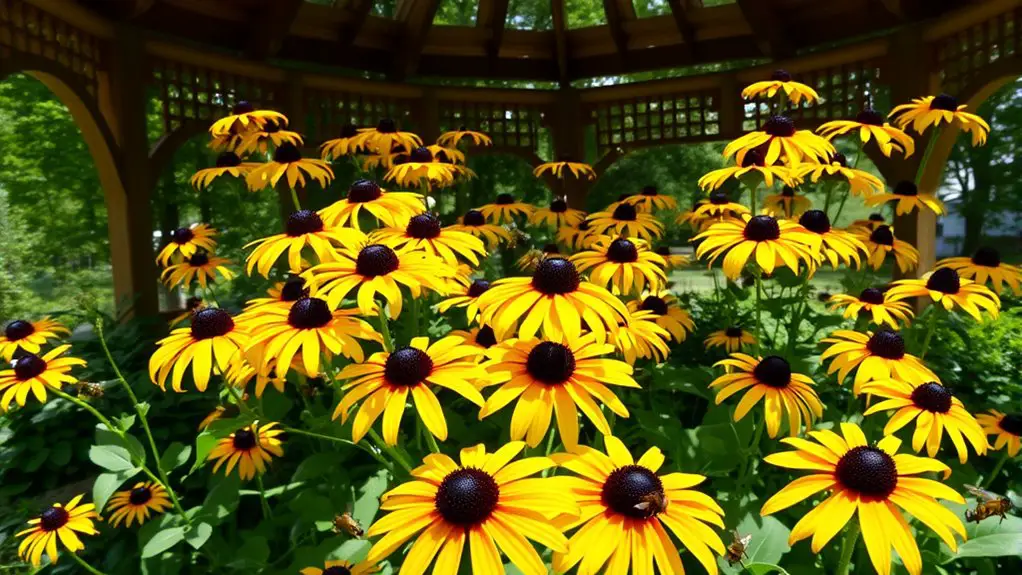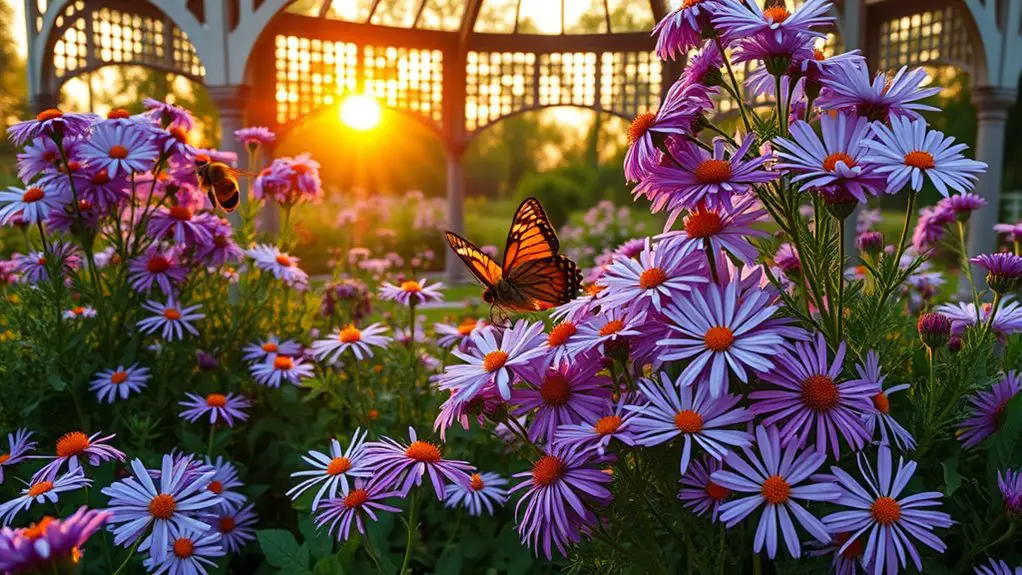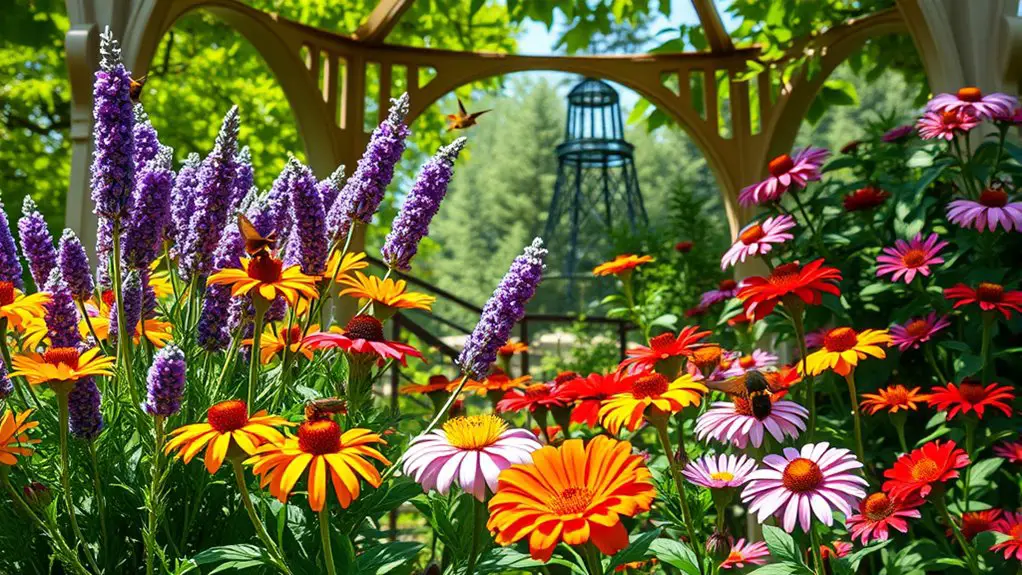For a gazebo garden, include plants like lavender for bees, coneflowers for butterflies, and milkweed, essential for monarch larvae. Black-eyed Susans offer vibrant blooms that attract various pollinators, while salvia draws in hummingbirds with its colorful flowers. Asters are perfect for late-season nourishment, supporting pollinators as they prepare for winter. These species not only enhance aesthetics but also contribute to biodiversity. Explore more varieties and tips for your pollinator-friendly garden to maximize its impact.
Lavender: A Fragrant Haven for Bees

If you’re looking to attract bees to your gazebo garden, consider incorporating lavender, as its aromatic flowers serve as an essential nectar source. The benefits of lavender extend beyond aesthetics; it fosters a thriving ecosystem by providing food for pollinators. Various lavender varieties, such as English lavender (Lavandula angustifolia) and French lavender (Lavandula dentata), offer different shades and scents, enhancing your garden’s appeal.
When planting lavender, guarantee it receives full sun and well-drained soil to thrive. Its drought-resistant nature means less water dependency, allowing you greater freedom in garden maintenance. Additionally, lavender’s essential oils can repel pests, creating a harmonious balance in your outdoor space. By choosing lavender, you not only cultivate a fragrant haven for bees but also contribute to a healthier environment. This plant’s dual purpose makes it a must-have in any pollinator-friendly garden design.
Coneflower: A Sturdy Favorite for Pollinators
Coneflowers are a robust addition to your gazebo garden, known for attracting essential pollinators like bees and butterflies. To guarantee their success, you’ll need to provide ideal growing conditions, such as well-drained soil and full sun. Regular care and maintenance, including deadheading and occasional watering, will help these vibrant plants thrive while supporting local ecosystems.
Attracting Essential Pollinators
While many plants can attract pollinators, few are as reliable and resilient as the coneflower (Echinacea). When you include coneflowers in your garden design, you’re not just adding beauty; you’re supporting pollinator diversity. Their vibrant blooms draw bees, butterflies, and other crucial pollinators throughout the growing season. These hardy plants thrive in various conditions, making them perfect for both novice and experienced gardeners. By planting coneflowers alongside other native species, you’ll create a rich ecosystem that encourages a wider range of pollinators. Consider clustering them in sunny spots to maximize their appeal. With the right garden design, coneflowers can become a cornerstone of your efforts to attract and sustain essential pollinator populations.
Care and Maintenance Tips
To guarantee your coneflowers thrive and continue to attract pollinators, consistent care and maintenance are essential. Begin by ensuring the soil quality is ideal; it should be well-drained and rich in organic matter. Implement a watering schedule that provides deep, infrequent watering, allowing the soil to dry between sessions. This encourages deep root growth, enhancing resilience.
- Regularly deadhead spent flowers to promote further blooming.
- Apply a balanced fertilizer in early spring to support growth.
- Monitor for pests and disease, addressing issues promptly to maintain plant health.
- Mulch around the base to retain moisture and suppress weeds.
Ideal Growing Conditions
When selecting a location for your coneflowers, it’s important to take into account their preference for full sun, as they thrive in at least six hours of direct sunlight each day. This exposure helps them produce vibrant blooms, attracting various pollinators. Additionally, make certain the soil quality is well-draining and nutrient-rich; sandy loam is ideal. Coneflowers can tolerate poor soil but will flourish in a balanced pH of 6.0 to 7.0. Regularly amend the soil with organic matter to enhance its fertility and drainage. Avoid overly wet conditions, as they can lead to root rot. By meeting these sunlight requirements and focusing on soil quality, you’ll create an inviting environment for both coneflowers and the pollinators they attract.
Milkweed: Essential for Monarch Butterflies
Milkweed is essential for the entire lifecycle of monarch butterflies, serving as the primary host plant for their larvae. When planting milkweed, it’s important to take into account their habitat needs, including sunlight and soil type, to guarantee successful growth. By incorporating milkweed into your gazebo garden, you can create a supportive environment for these iconic pollinators.
Monarch Lifecycle Stages
As you cultivate a pollinator-friendly garden, understanding the lifecycle stages of monarch butterflies becomes essential, especially given their dependence on milkweed. Monarchs undergo four distinct stages: egg, larva (caterpillar), pupa (chrysalis), and adult butterfly. Each stage is vital for their development and survival.
- Monarch eggs are laid on the underside of milkweed leaves, ensuring a food source for the hatching larvae.
- The caterpillar stages involve multiple molts, during which they rapidly grow and store energy.
- After about two weeks, they form a chrysalis where metamorphosis occurs.
- Finally, the adult butterfly emerges, ready to continue the cycle, promoting biodiversity in your garden.
Habitat and Planting Tips
Creating a supportive habitat for monarch butterflies starts with selecting the right plants, particularly milkweed, which serves as the sole food source for their larvae. When employing effective plant selection strategies, opt for native milkweed varieties like Asclepias tuberosa or Asclepias incarnata. These plants thrive in your garden’s conditions, enhancing biodiversity.
Incorporate garden design principles that promote sun exposure and shelter from wind; this encourages a healthy environment for both milkweed and adult butterflies. Grouping milkweed with nectar-rich flowers creates a vibrant ecosystem, attracting pollinators while providing essential resources. Confirm you maintain soil health and moisture levels, as these factors influence plant vigor. By following these guidelines, you’ll create a flourishing habitat that supports monarch butterflies and their incredible life cycle.
Black-eyed Susan: Bright Blooms for Busy Bees

Black-eyed Susans, with their vibrant yellow petals and dark centers, are a staple in any pollinator-friendly garden. These cheerful flowers not only brighten your space but also serve as a crucial resource for pollinators, particularly bees. By incorporating black-eyed Susans into your gazebo garden, you’re enhancing biodiversity and supporting local ecosystems.
- Pollinator Attraction: Their nectar-rich blooms draw in a variety of bees and butterflies.
- Low Maintenance: They thrive in diverse soil types and require minimal care.
- Extended Blooming Season: They flower from summer into fall, providing a consistent food source.
- Drought Tolerance: Once established, they’re resilient to dry conditions, making them ideal for sustainable gardening.
Embracing black-eyed Susan benefits isn’t just about aesthetics; it’s a commitment to fostering a thriving habitat for indispensable pollinators in your garden.
Salvia: A Colorful Magnet for Hummingbirds
When you incorporate salvia into your gazebo garden, you’re not just adding a splash of color; you’re also attracting hummingbirds, which play an essential role in pollination. Salvia varieties, such as Salvia guaranitica and Salvia splendens, are particularly alluring with their vibrant blooms and tubular shapes, making them irresistible to these feathered friends. Planting salvia alongside your hummingbird feeders creates a harmonious environment, encouraging frequent visits from these pollinators.
These plants thrive in well-drained soil and prefer full sun, making them ideal for bright, sunny spots around your gazebo. Their long blooming periods provide a consistent nectar source throughout the growing season. Additionally, salvia is relatively low-maintenance, requiring minimal watering once established. By choosing diverse salvia varieties, you can guarantee your garden remains a colorful and dynamic sanctuary for hummingbirds, enhancing both the beauty and ecological health of your outdoor space.
Aster: Late Season Nectar for Pollinators

Although many flowers bloom in the spring and summer, asters stand out as a crucial late-season nectar source for pollinators. These hardy perennials provide significant sustenance for bees and butterflies as they prepare for winter. With numerous aster varieties available, you can easily find ones that suit your garden’s aesthetic and pollinator needs.
To guarantee the success of your asters, consider the following maintenance tips:
- Choose the right variety: Select from low-growing species to tall forms, ensuring a diverse display.
- Proper spacing: Allow enough room for growth to prevent overcrowding and promote air circulation.
- Water wisely: Keep the soil consistently moist but avoid waterlogging, which can harm roots.
- Deadhead regularly: This encourages more blooms and prolongs the flowering period, benefiting late-season pollinators.
Incorporating asters into your gazebo garden not only enhances beauty but also supports crucial wildlife.
Frequently Asked Questions
How Do I Attract More Pollinators to My Gazebo Garden?
To attract more pollinators to your gazebo garden, focus on native flower selection, ensuring diverse blooms, and optimize your garden layout by creating clusters of flowers. This’ll enhance their foraging experience and encourage more visits.
What Is the Best Planting Time for These Pollinator-Friendly Plants?
The best planting time for pollinator-friendly plants is in spring, after the last frost, or during fall, allowing roots to establish before winter. Both timings enhance growth and attract diverse pollinators to your garden.
Are These Plants Drought-Resistant or Do They Require Regular Watering?
In the garden’s dance with nature, some plants boast drought tolerance, needing less water, while others thrive on regular watering. You’ll want to balance your watering frequency to maintain their vibrant health and pollinator appeal.
Can I Grow These Plants in Containers?
Yes, you can grow these plants in containers. For successful container gardening, focus on proper plant selection, ensuring each species thrives within its space, receives adequate light, and has sufficient drainage for ideal growth.
How Do I Maintain These Plants for Optimal Pollination?
To maintain your plants for ideal pollination, utilize precise pruning techniques and prioritize soil health. Regularly check moisture levels, enrich with organic matter, and provide diverse blooms to attract a variety of pollinators.

